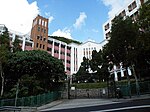Hong Kong Island (1998 constituency)

The Hong Kong Island geographical constituency was one of the five geographical constituencies in the elections for the Legislative Council of Hong Kong from 1998 to 2021. It was established in 1998 for the first SAR Legislative Council election and was abolished under the 2021 overhaul of the Hong Kong electoral system. In the 2016 Legislative Council election, it elected six members of the Legislative Council using the Hare quota of party-list proportional representation. The constituency covered all the four districts on the Hong Kong Island, namely, Central and Western, Eastern, Southern and Wan Chai. In 2020, it had 707,277 registered voters.
Excerpt from the Wikipedia article Hong Kong Island (1998 constituency) (License: CC BY-SA 3.0, Authors, Images).Hong Kong Island (1998 constituency)
Broom Road, Hong Kong Island Happy Valley (Wan Chai District)
Geographical coordinates (GPS) Address Nearby Places Show on map
Geographical coordinates (GPS)
| Latitude | Longitude |
|---|---|
| N 22.264444444444 ° | E 114.18722222222 ° |
Address
蟠廬 15-21 Broom Road
Broom Road 15-21
Hong Kong Island, Happy Valley (Wan Chai District)
Hong Kong, China
Open on Google Maps










